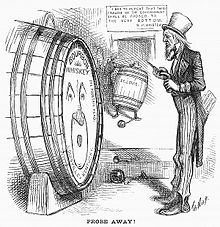Whiskey Ring
This article needs additional citations for verification. (March 2019) |

The Whiskey Ring was an American scandal, exposed in 1875, involving the diversion of tax revenues in a conspiracy among government agents, politicians, whiskey distillers, and distributors.
History[]
The scheme involved an extensive network of bribes involving distillers, government officials, rectifiers, gaugers, storekeepers, and internal revenue agents. Essentially, distillers bribed government officials, and those officials helped the distillers evade federal taxes on the whiskey they produced and sold. Due to the increase of liquor taxes after the Civil War, whiskey was supposed to be taxed at 70 cents per gallon. However, distillers would instead pay the officials 35 cents per gallon and the illicit whiskey was stamped as having the tax paid. Before they were caught, a group of politicians were able to siphon off millions of dollars in federal taxes.
Due to its ties within the government, the Whiskey Ring was thought to be impregnable.[citation needed] That was until U.S. Secretary of the Treasury Benjamin Bristow, working without the knowledge of the President or the Attorney General, broke up the tightly connected and politically powerful ring using secret agents from outside the Treasury Department to conduct a series of raids across the country on May 10, 1875. The trials began at Jefferson City, Missouri in October 1875. Ultimately, of 238 people who were indicted, 110 convictions were made and more than $3 million in taxes were recovered.[1] President Ulysses S. Grant appointed General John Brooks Henderson (a former U.S. Senator from Missouri) to serve as special prosecutor in charge of the indictments and trials, but Grant eventually fired Gen. Henderson for challenging Grant's interference in the prosecutions. Grant replaced Henderson with attorney James Broadhead.
The Whiskey Ring was seen by many as a sign of corruption under the Republican governments that took power across the nation following the American Civil War. General Orville E. Babcock, the private secretary to the President, was indicted as a member of the ring. He was acquitted through the personal intervention and testimony of President Grant.[2] Newspapers at the time were known to slant toward a Republican agenda, making light of the trial. [1] This led many people to think the Whiskey Ring was a ploy for the Republican party to increase their funds. [1] For this reason, President Grant, although not directly involved in the ring, came to be seen as emblematic of Republican corruption, and later scandals involving his Secretary of War William W. Belknap only confirmed that perception. The Whiskey Ring, along with other alleged abuses of power by the Republican party, contributed to a national weariness of Reconstruction, which ended Grant's presidency with the Compromise of 1877.
References[]
- ^ Jump up to: a b c Hopper, Jennifer Rose (21 November 2017). "Reexamining the Nineteenth-Century Presidency and Partisan Press: The Case of President Grant and the Whiskey Ring Scandal". Social Science History. 42 (1): 109–133. doi:10.1017/ssh.2017.40. S2CID 149135246.
- ^ Columbia Electronic Encyclopedia. OCLC 746941797.
Further reading[]
- Cooper, Edward S. (2016). John McDonald and the Whiskey Ring: From Thug to Grant's Inner Circle. Rowman & Littlefield. ISBN 978-1-6839-3013-6.
- McDonald, John (1880). Secrets of the great whiskey ring; and Eighteen months in the penitentiary. St. Louis, Mo., W. S. Bryan.
- Felton, Franklin Eliot (1870). The Secrets of Internal Revenue: Exposing the Whiskey Ring, Gold Ring, and Drawback Frauds. William Flint, philadelphia.
External links[]
- Political corruption scandals in the United States
- 1875 in the United States
- Grant administration controversies
- 1776 in the United States